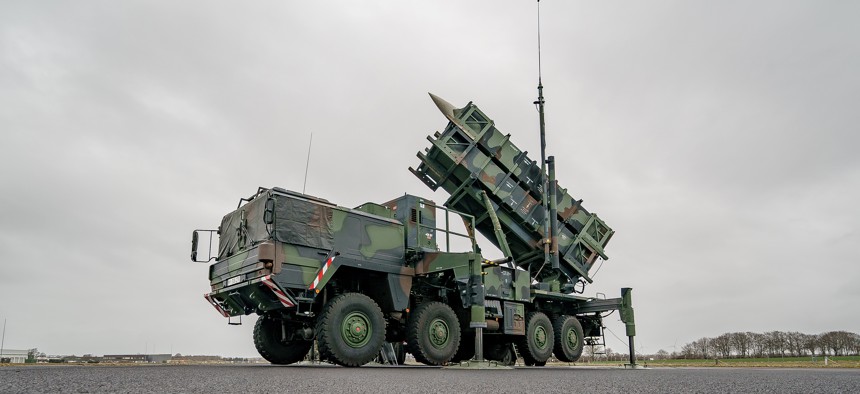
A combat-ready Patriot anti-aircraft missile system of the Bundeswehr's anti-aircraft missile squadron 1 stands on the airfield of Schwesing military airport. Photo by Axel Heimken/picture alliance via Getty Images
Kahl: U.S. Focused on ‘Next Phase’ of Ukraine Conflict
A big aid package is expected this week, but it likely won’t contain long-sought, controversial items like ATACMS.
In the weeks ahead, frontline progress in the war in Ukraine will be measured not in miles but in “hundreds of meters,” defense undersecretary for policy Colin Kahl told reporters at the Pentagon on Wednesday.
Kahl, who just returned from a trip to Ukraine for meetings with that nation’s leadership, said the United States is focused on “surging those capabilities to Ukraine for the next phase of the conflict to really try to change that dynamic and continue the momentum that the Ukrainians had in the late summer and early fall.”. But that doesn’t portend a big change in the types of equipment the U.S. might send.
Kahl spoke to reporters ahead of a meeting of the Defense Contact Group in Germany later this week. The group is the assembly of nations providing military and other forms of aid to Ukraine. Observers expect the United States to announce a substantial aid package at the meeting, but some items Ukraine has asked for will not be on the list. For instance, Ukraine has repeatedly said that it wants more tanks to break through entrenched Russian positions in the country’s east. And they’ve been asking for long-range guided ATACMS missiles since the start of the conflict.
Ukraine has also asked Germany to send Leopard 2 tanks, and if the U.S. sends M1 Abrams tanks, that could compel Germany to to follow suit. But Kahl said logistics barriers and other concerns are contributing to the Biden administration’s reservations. “The Abrams tank is a very complicated piece of equipment. It's expensive. It's hard to train on…I think it's about three gallons to the mile of… fuel.”
On the issue of longer-range fires such as ATACMS, which would allow Ukraine to strike targets 185 miles away, Kahl likewise indicated no change in the Biden administration’s policy. “Our position has been—as a matter of US policy—we're not comfortable enabling strikes into Russia. We'll let you know if that changes, but that's current U.S. policy,” he said. However, the United States could send ground-launched Small Diameter Bombs, Politico reported, which have a range of 100 miles.
The new Republican majority in Congress could add a new dynamic to the conversation about how the United States aids Ukraine. Some 44 percent of registered Republican voters in a November poll said the United States is doing too much to help Ukraine’s defense efforts, and some members, such as Rep. Paul Gosar, R-Ariz., have even gone so far as to say that Ukraine is not an ally of the United States.
But that view isn’t shared by the party’s leadership. Rep. Mike Rogers, R-Ala., the incoming chair of the House Armed Services Committee, released a statement on Wednesday urging the administration to be bolder in the weapons it sends to Ukraine.
“The current handwringing and hesitation by the Biden administration and some of our European allies in providing critical weapon systems to Ukraine stinks of the weak policies of 2021, such as not sanctioning Nord Stream 2 or providing U.S.-origin Stingers before the full-scale invasion. While those policies failed to deter this conflict, the current indecision and self-deterrence will prolong it—costing Ukrainian lives. Now is the time for the Biden and [German] Scholz governments to follow the lead of our U.K. and Eastern European allies—Leopard 2 tanks, ATACMS, and other long-range precision munitions should be approved without delay,” it reads.
However, Kahl said the main thing Ukraine needs is more capable air defenses.
“At, I think, the top [of the needs list] very remains air defense. Andit's more systems, but it's also keeping their Soviet legacy systems that have proven extraordinarily effective, viable. Clearly, the Russians are hoping that through the mix of their cruise missile strikes, you know, rejiggering their air defense systems as surface-to-surface ballistic missiles, and the use of Iranian drones, they're clearly trying to turn the lights out across Ukraine…So Ukrainians know that. We know that, and as a consequence, we're committed to keeping, making sure that the Ukrainians’ [air defenses] remain viable.”




